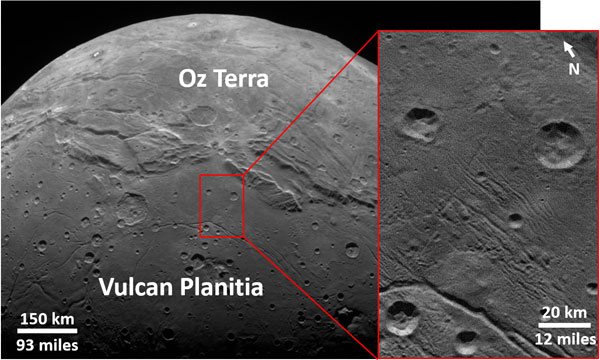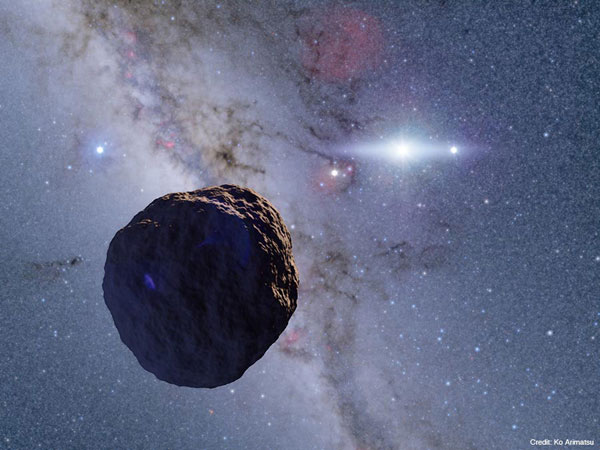Scientists studying New Horizons images of craters on Pluto and its moon Charon have found that the Kuiper Belt must contain fewer small objects than expected — which suggests the outer solar system hasn’t changed much since its earliest days.
When NASA’s New Horizons mission sped by Pluto and its moon Charon in 2015, it captured almost half of each world in incredible detail. Every pixel could capture features as small as 76 meters across on Pluto and 154 meters across on Charon. For reference, that’s equivalent to discerning the hulk of Godzilla on these worlds’ surfaces (depending on the movie: Godzilla was 75 meters tall in 1984 but grew to 150 meters by 2014.)
It wasn’t monsters that scientists were seeking, though, but the marks left by some of the smallest objects in the Kuiper Belt. The sparse ring of icy rocks that edges our solar system may represent the primordial leftovers of planet formation. But until now, scientists weren't sure how pristine these objects really were. In the March 1st Science, Kelsi Singer (Southwest Research Institute) and her colleagues tallied up the craters on a few of the older surfaces of Pluto and its moon, and their findings point to a Kuiper Belt that's been largely untouched since its earliest days.
Counting Craters

NASA / JHUAPL / LORRI / SwRI
Usually, whether you’re talking asteroids, stars, or galaxies, there are many more small things than large things in the universe. But what Singer’s team found on Pluto and Charon was that craters less than a certain diameter — specifically, less than 13 kilometers (8 miles) across — were surprisingly scarce in number.
When a rock crashes onto a larger body, the crater it makes is typically much larger than the rock itself. For Pluto and Charon, a scarcity of craters less than 13 kilometers across translates to a scarcity of Kuiper Belt objects that span less than 1 to 2 kilometers. There's some uncertainty in the details of that translation, acknowledges coauthor Alex Parker (also at Southwest Research Institute). Nevertheless, whatever objects are making craters on these worlds, they tend to be on the bigger side.
Geological processes such as cryovolcanism and glacial activity can't have simply smoothed out Pluto’s and Charon’s surfaces, the scientists say, because such resurfacing would have erased the bigger craters along with the small ones. There are no known processes that would preferentially erase the smaller craters, the team concludes. What's more the crater counts for Pluto and Charon are in line with similar studies of the moons of Jupiter and Saturn: Small craters are likewise lacking on these moons.
Too Few or Too Many? And Why It Matters

Ko Arimatsu
“I am not convinced by any of these occultation detections yet,” says Parker. “For each of these kinds of one- or two-off events, there are innumerable alternative possibilities for what they may have been other than occultations of stars by Kuiper Belt Objects.”
For his part, Arimatsu argues, “I suppose that further studies of resurfacing processes are required because Pluto and Charon (and also Ultima Thule, possibly) seem to be geologically unique, and unexpected resurfacing processes can happen.”
At the same time, Arimatsu points out, “we discovered only ONE object, and there is still a large uncertainty in our size distribution results.” It’s even possible, he adds, that his team’s occultation isn’t totally inconsistent with what the New Horizons team found.
The question of how many kilometer-size Kuiper Belt objects there are might seem a bit like asking how many angels dance on the head of a pin. But the answer has potentially far-reaching implications for our understanding of planet formation in the early solar system.
If there are few kilometer-size objects out there then that might mean the Kuiper Belt is so sparse that objects haven’t spent too many of the past 4 billion years running into each other. Collisions, after all, typically create many small things out of a few big things. And if collisions have been relatively rare, then what we see out there now is what was there initially. That is, the Kuiper Belt would represent the solar system pretty much as it existed during its formation.
If the Kuiper Belt has remained pristine since its earliest days, then the relative sizes of objects within it could shed light on planet formation. For example, the size distribution that Singer and colleagues find supports the idea that the giant planets formed when gravitational instabilities led to runaway growth.
What the Future Holds
Both teams agree that future occultation surveys — such as the Transneptunian Automated Occultation Survey (TAOS-II) — are crucial to truly understanding the Kuiper Belt. TAOS-II, for example, will capture the sky at a rate of 20 frames per second. That’s only a little faster than the OASES setup, which captured 15.4 frames per second, but it makes a difference in what TAOS-II will see.
“High frame rates are absolutely necessary because the shadows cast by objects this size and distance from us are not like the shadows we are used to seeing around us every day,” Parker explains. As the shadow of a Kuiper Belt object sweeps over Earth, observers see the starlight it’s blocking fade and brighten, fade and brighten, a double pattern known as Fresnel diffraction. “The characteristic flickering of these diffraction fringes within the shadow is what provide strong confirmation of the occulting object's properties.”
Moreover, TAOS-II is designed to capture not just a single occultation event but hundreds of them. By combining many observations, astronomers will finally gain a much better understanding of the Kuiper Belt population.
 0
0









Comments
You must be logged in to post a comment.